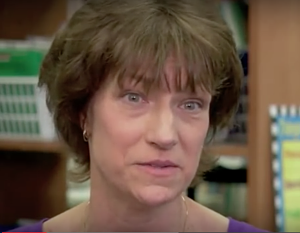Teaching Common Core Math to K–2 Students
Lori Woods teaches at Greenbrook Elementary, a Title 1 K-5 school in South Brunswick, New Jersey. The suburban district in the central part of the state has a diverse student population that includes many English language learners, and more than 25 percent of students get free or reduced lunch. In this interview, she discusses her approach to teaching Common Core math to her youngest students.
 THE Journal: What grade(s) and subjects do you teach?
THE Journal: What grade(s) and subjects do you teach?
Lori Woods: I am the instructional support teacher for kindergarten through second grade, and I provide small-group instruction for students in reading and math.
THE Journal: What devices do you and your students use in class?
Woods: My students use iPads in my classroom.
THE Journal: How has your pedagogy changed (if at all) because of the transition to Common Core?
Woods: I expect my students to manipulate numbers in many ways, to use strategies to solve problems, to explain their thinking to me and to others. I want them to have a deep understanding of our base-ten number system. They need to know if an answer is reasonable. I want them to learn to find all the solutions that fit, rather than one answer. Automaticity in math facts is a goal, but using their understanding of place value to solve problems confidently and with ease is an even more powerful goal. I know that I have raised the bar on what I expect from my students.
THE Journal: When did you start using Tabtor Math app, and what inspired you to start using it?
Woods: Two-and-a-half years ago, my principal said, “Lori, there's something I want you to see." Within minutes of the brief introduction, I could imagine the impact that this app would have on my students. I knew that it would allow me to differentiate at the individual student level and that the level of engagement would increase dramatically because of the iPad.
THE Journal: Can you give me examples of how specifically you use it with students?
Woods: I use Tabtor for all of the following:
- To determine student strengths and weaknesses (diagnostic assessments);
- for double-dose instruction/practice following lessons in the general education classroom in all concepts;
- to provide practice for basic facts in all operations;
- to challenge/accelerate students who have demonstrated advanced number sense;
- to build multiple strategies for computation;
- to begin to develop place-value understanding for kindergartners;
- for spiral review of all previously taught skills;
- to help students see themselves as competent mathematicians;
- to help students develop a love of learning mathematics;
- to develop perseverance in students; and
- to have students self-determine goals.
THE Journal: How does Tabtor help you teach to Common Core? What specific standards are you meeting?
Woods: When New Jersey adopted the Common Core, as we awaited PARCC, our district math committee (of which I am a member), worked diligently to develop assessments which would allow us to evaluate student competencies in the mathematics concepts of the CCCS.
We thought that we had developed questions which required students to demonstrate proficiency in every standard at every grade. Then, I began using Tabtor. The assignments on the app require children to understand concepts very deeply. For example, when building multiplication skills, the students use repeated addition, missing factors, arrays, skip counting — all ways of understanding the operation and developing automaticity. They learn the relationship between multiplication and division. They apply those concepts to the solution of word problems.
All CCCS standards in math are addressed in Tabtor. I can provide sequences in a particular concept or spiral back to any previously taught skills by placing those assignments in the student queues.
THE Journal: Have you seen any measurable changes in student achievement since you started using Tabtor? What about student engagement?
Woods: Yes, our instructional support students in grades kindergarten through fifth grade, worked at an overall accuracy rate of 93.5 percent on their Tabtor assignments during the 2014–2015 school year. The children successfully applied their acquired skills on the end-of-year district assessments in mathematics.
We speak so much of measureable data. To me, even more important than scores on assessments is the growth in confidence and perseverance that we see in the children who use Tabtor. The children literally run to get to “math club,” as we call it. They are engaged and excited for the entire class time. The children ask for more club days, more time on Tabtor. The children strive for perfect scores and high point totals.
We celebrate their success on the Wall of Fame for mathematicians. They receive honors from our principal. They believe that they are mathematicians, and they are. When the foundation is this strong and the children believe in themselves, they have the ingredients for success. It may not be measureable, but it is so visible and very real.
About the Author
Christopher Piehler is the former editor-in-chief of THE Journal.